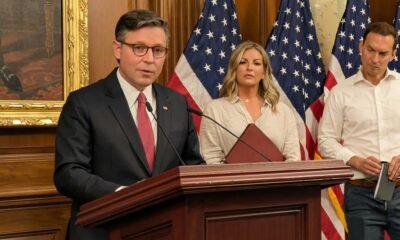Business
Republicans Challenge Crucial Tax Funding State Medicaid Programs

The recently approved tax and spending bill by the U.S. House has significant implications for how states fund their Medicaid programs. This legislation aims to cap or freeze the taxes imposed on medical providers, a strategy many states utilize to enhance federal Medicaid funding. As a consequence, states could face substantial deficits in their Medicaid budgets.
This change would force states to make tough decisions: either supplement the lost federal funding with state dollars, curtail services, or provide coverage to fewer individuals. Medicaid, a partnership between state and federal governments, mainly benefits low-income populations, including children, caregivers, those with disabilities, and pregnant women, with federal matching funds ranging from 50% to 77% based on the state’s wealth.
For instance, if a state collects $100 million from provider taxes, it can leverage that revenue to obtain an additional $100 million in federal matching funds, effectively doubling its Medicaid spending capacity. Currently, 49 states utilize such funding strategies, with provider taxes accounting for 17% of Medicaid spending in 2018, showing a significant increase since 2008.
Under the new proposal, House Republicans seek to limit these provider taxes as part of a broader initiative to reduce federal Medicaid expenditures by approximately $625 billion over the next decade. By capping state provider taxes and adding work requirements for Medicaid recipients, this measure aims to tighten budgets significantly.
According to the Congressional Budget Office, eliminating provider taxes could result in substantial federal government savings over the next ten years. Critics argue that these taxes are simply an accounting maneuver that allows states to acquire more funds from Washington without fully covering their share of the Medicaid program. Some have branded these taxes as a form of “money laundering.”
Dr. Mehmet Oz, head of the Centers for Medicare & Medicaid Services, remarked on the complexities of these state tax schemes that shift Medicaid responsibilities and potentially burden federal taxpayers. Brian Blase, president of the Paragon Health Institute, echoed this sentiment, referring to the taxes as mechanisms through which states might unfairly profit at the expense of federal funds.
However, many supporters, including state Medicaid directors and healthcare organizations, defend these taxes as vital tools that sustain essential services and funding for Medicaid programs. The abrupt removal of these taxes is projected to lead to critical service cuts and even hospital closures.
Jason Pray, vice president of legislative affairs at America’s Essential Hospitals, emphasized that while these taxes may be unwelcome, they help maintain essential care services within communities. “Without this funding, states will have to raise taxes on individuals to preserve healthcare access,” he warned.
Opponents of the provider tax concept, like Blase, argue that they allow hospitals to fetch excessive profits from the additional federal matching funds, proclaiming it as a form of undeserved “corporate welfare.” Yet, Pray contends that many facilities face financial challenges, and these taxes are crucial for their survival rather than for corporate gain. He noted that support for these taxes has historically received bipartisan backing.
Edwin Park from the Georgetown University McCourt School of Public Policy raised concerns about the ongoing viability of these taxes. He pointed out that not all hospitals benefited equally; those serving a low-income patient base are likely to be the most affected.
State officials such as Jay Ludlam from North Carolina Medicaid also expressed alarm over potential budget shortfalls caused by the proposed limitation on provider taxes. He stated that the revenue generated from these taxes is integral to sustaining Medicaid services in the state, warning that financial constraints would necessitate reductions in eligibility and overall services.


















